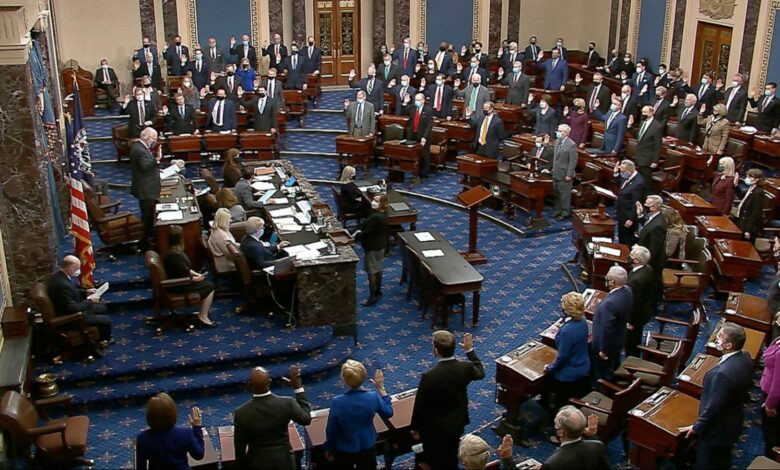Key arguments by Trump”s lawyers ahead of trial

Key arguments by Trump”s lawyers ahead of trial
Former President Donald Trump stands trial before the Senate this week on an impeachment charge that accuses him of inciting the deadly Jan. 6 riot at the US Capitol.
His lawyers in a 78-page memorandum on Monday detailed a range of legal and factual arguments that they intend to make at trial.
Some of the highlights:
ARGUMENT: TRUMP DID NOT INCITE THE INSURRECTION
Defence lawyers are adamant that Trump did not incite the riot when he addressed a huge crowd of supporters at a rally that preceded it.
They accuse House impeachment managers of cherry-picking Trump’s statements from an hourlong speech by highlighting only those that Democrats see as helpful to their case, pointing out repeatedly that he had told his supporters to peacefully and patriotically make your voices heard.”
They argue that even the statement that has attracted the most notoriety If you don’t fight like hell, you’re not going to have a country anymore was figurative in the general context of election security, not an invocation to violence. And they suggest Trump couldn’t have himself incited the riot given the indications law enforcement had before Jan. 6 of the potential for violence that day.
But for Democrats, the focus on those specific statements at the rally on the Ellipse ignores the cumulative impact of Trump’s baseless, weekslong efforts to call into question the results of the presidential election, and his urging of supporters to come to Washington on the day that the Senate was set to certify the results of Joe Biden’s victory.
There was no widespread fraud in the election, as Trump claimed falsely over several months and again to his supporters just before the insurrection. Election officials across the country, and even then-Attorney General William Barr, contradicted his claims, and dozens of legal challenges to the election put forth by Trump and his allies were dismissed.
ARGUMENT: HIS SPEECH IS PROTECTED
The Trump legal team plans to lean on the Constitution in multiple ways, including by arguing that Trump enjoyed First Amendment protections in everything he said to his supporters.
The fatal flaw of the House’s arguments is that it seeks to mete out governmental punishment impeachment based on political speech that falls squarely within broad protections of the First Amendment, the lawyers say.
In a seminal Supreme Court case, Brandenburg v. Ohio, the justices held that the government can suppress speech that is designed to produce imminent lawless action and is likely to do so. But Trump’s lawyers say his words at the Ellipse don’t come close to meeting that standard.
In their own filing Monday, House Democrats say the First Amendment defense is lacking since Trump was not impeached for expressing an unpopular political opinion but rather because he willfully incited violent insurrection against the government.
Rights of speech and political participation mean little if the President can provoke lawless action if he loses at the polls the Democrats wrote.
ARGUMENT: THE TRIAL ITSELF IS UNCONSTITUTIONAL
This is disputed among legal scholars, but Trump’s legal team plans to argue that the trial itself is unconstitutional because he is no longer in office. They say the Constitution does not extend the power of impeachment against a private citizen.
They insist that conviction at an impeachment trial requires the possibility of removing the defendant from office. Now that Trump is out of the White House, they say, there is no legal basis for such a trial.
Not so, say Democrats, who say there is indeed historical precedent albeit not for a president to conduct an impeachment trial for someone no longer in office for acts committed while that person was in office. They argue there is no January exception for a president’s final days in office.
Their argument got a boost Sunday when Charles Cooper, a conservative Washington lawyer with deep ties to the Republican legal community, wrote in a Wall Street Journal opinion piece that a trial of Trump did indeed pass constitutional muster.
DEMOCRATS HAVE THEIR OWN STATEMENTS AND ACTIONS TO ANSWER FOR
Trump’s lawyers signalled that they’ll look to defend Trump by invoking other examples of what they say is similar political rhetoric from Democrats.
They point to a statement that House Speaker Nancy Pelosi made at a 2018 news conference about the Trump administration’s zero tolerance policy on immigration. I just don’t even know why there aren’t uprisings all over the country. Maybe there will be,” she said.
It’s unclear whether making a comparison with a statement like that, which did not result in violent uprisings aimed at the Trump administration, will actually resonate with a Senate audience, especially as Trump’s lawyers try to make the claim that their own client’s words are being taken out of context. Trump’s speech to supporters came after he falsely claimed for weeks that the election was being stolen from him and pressured state and local officials to change the outcome.
Beyond those statements, the legal filing suggests other Democrats may find themselves name-dropped in unexpected ways during the trial. Trump’s lawyers argue the trial creates a dangerous slippery slope for politically charged impeachments. It posits, for instance, that both Biden and Hillary Clinton could be impeached for actions during the Obama administration.




